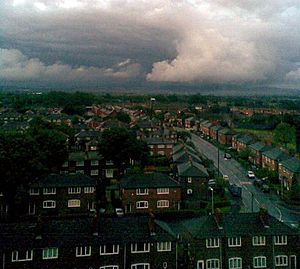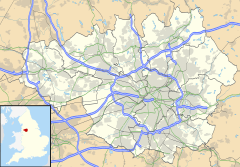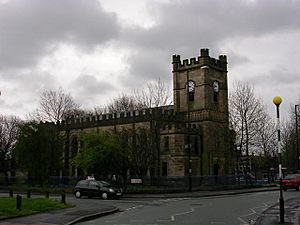Newton Heath facts for kids
Quick facts for kids Newton Heath |
|
|---|---|
 A view over Newton Heath |
|
| OS grid reference | SD878004 |
| • London | 163 mi (262 km) SSE |
| Metropolitan borough | |
| Metropolitan county | |
| Region | |
| Country | England |
| Sovereign state | United Kingdom |
| Post town | MANCHESTER |
| Postcode district | M40 |
| Dialling code | 0161 |
| Police | Greater Manchester |
| Fire | Greater Manchester |
| Ambulance | North West |
| EU Parliament | North West England |
| UK Parliament |
|
Newton Heath is an area in Manchester, England. It is about 2.8 miles (4.5 km) northeast of the city centre. Around 9,883 people live there.
Long ago, Newton Heath was part of Lancashire. It was mostly a farming area. But then the Industrial Revolution happened. This changed the area into a place with many factories. Engineering became the main industry. Many people also worked in mining and textiles in nearby areas like Clayton Vale and Bradford.
Newton Heath used to be much bigger. It included what is now Miles Platting and reached all the way to Failsworth. Rivers and brooks surrounded it on all sides. These were the River Medlock, Moston Brook, Newton Brook, and Shooters Brook. When Miles Platting was created, the rest of the area became known as Newton Heath.
Manchester United Football Club has strong ties to this area. The club actually started here! It was first known as Newton Heath Lancashire and Yorkshire Railway Football Club.
Contents
History of Newton Heath
All Saints Church
The church of All Saints Newton Heath started as a small chapel around 1556. This was a time of big religious changes in England. The first chapel was built from wood and mud. It was one of the first chapels linked to the Manchester Collegiate Church.
This chapel stood on a wild, open area. It was on the highest ground, right on an old Roman road. This road connected important towns like Chester, Manchester, and York.
The chapel was rebuilt in 1598. When it was rebuilt again in 1814, workers found an old timber with the date 1556 carved on it. This showed how old the first building was.
The chapel built in 1598 had walls made of oak and mud. It was whitewashed. There was a gallery inside, reached by stone stairs outside. The floor was bare earth, which was very cold. In winter, people would spread rushes on the floor. There were even stocks outside for male offenders. Women who misbehaved during services had to stand in a special stall in the gallery as a punishment.
In 1738, the mud walls were replaced with bricks. But by 1795, the building was unsafe. On May 1, 1808, the building finally collapsed. Even after it fell down, services continued among the ruins for five more years!
The church you see today was built in 1814. It was designed by William Atkinson. Money for the church came from taxes and by renting out church pews. The church was made bigger in 1879. Today, the building is on an "At Risk Register" because it needs repairs.
Industrial Growth
In the 1500s, French Huguenots came to Newton Heath. They were escaping unfair treatment in their home country. They brought skills like cotton and linen weaving and bleaching. This changed Newton Heath's small home-based industries. It became a place of large factories and mass production. For example, Newton Silk Mill was built in 1825.
The Rochdale Canal helped move raw materials and finished products easily. Later, other industries came to the area. These included a soap factory, a match factory, and rope works. There were also engineering and glass-making companies. Many small, cheap houses were built for the new workers. This changed Newton Heath from a farming area to an industrial one forever.
In the 1700s, Oldham Road became a main road. A toll booth was put up to collect money from travelers. This road is still a main route through the area. By the early 1800s, the Rochdale Canal was built. This brought more industry and growth to the area. The local population grew almost 20 times during the 1800s.
Famous Companies
Newton Heath was home to several well-known companies. Mather & Platt built a huge factory here. They made pumps, electrical machines, and fire sprinkler systems. The aircraft maker Avro also started in Newton Heath before moving to other places. Another local company, Heenan & Froude, designed the steel structure for Blackpool Tower.
P. Frankenstein and Sons Ltd. made special rubber fabrics. They supplied life vests to the Royal Air Force. Their main office was on Culcheth Lane.
The Wilson's & Co brewery on Monsall Road started in 1834. It later merged with another company and was bought by Watney Mann. The brewery closed in 1987.
Manchester United's Beginnings
Newton Heath is famous as the birthplace of Manchester United Football Club. The club started in 1878. It was first called Newton Heath Lancashire and Yorkshire Railway Football Club. Frederick Attock, an engineer for the Lancashire and Yorkshire Railway, formed the team.
The team played on a field at North Road. They wore green and gold jerseys. By 1892, they joined the Football League. The club stayed in Newton Heath until 1893. Then, they moved to Bank Street in nearby Clayton. In 1902, the name was changed to Manchester United Football Club.
Before the name change, Newton Heath FC's biggest successes were joining the First Division in 1892. They also won the Lancashire Senior Cup in 1898.
FC United of Manchester
There were plans to build a new football stadium for F.C. United of Manchester at Ten Acres Lane. The club hoped to move there by the 2012–13 season.
Manchester City Council approved the stadium plans in 2010. However, due to cuts in government funding, the project stopped. The council had to change its offer. The Ten Acres Lane site is now being used for other things. F.C. United instead partnered with Moston Juniors Football Club. They built a new stadium, Broadhurst Park, in nearby Moston in 2015.
How Newton Heath is Governed
A small area called Kirkmanshulme used to be part of Newton Heath. Belle Vue is now on that land. Only Kirkmanshulme Lane reminds people of it today. Newton Heath became part of the city of Manchester in 1890.
Newton Heath is in the Manchester Central area for Parliament. This area also includes Manchester city centre, Hulme, Beswick, Clayton, Openshaw, and Moss Side. As of 2012, Lucy Powell from the Labour Party is the Member of Parliament for this area. Local councillors are June Hitchen, John Flanagan, and Carmine Grimshaw. They are also Labour Party members.
Geography of Newton Heath
 |
Moston | New Moston | Failsworth |  |
| Miles Platting | Droylsden | |||
| Beswick | Clayton | Openshaw |
Newton Heath is a city area. It is surrounded by places like Clayton, Monsall, Moston, Failsworth, Miles Platting, Bradford, and Ancoats. It is south of the A62 (Oldham Road). This is the main road between Oldham and Manchester city centre.
To the south is Clayton Vale. This used to be an industrial area. Now, it has become a wild, natural space.
Economy in Newton Heath
Newton Heath has several well-known businesses. However, some companies have moved or closed down. Princes Food & Drink Group has a soft drinks factory on Grimshaw Lane. Manchester Abattoir, on Riverpark Road, used to be the main place for meat in the city. But it has become smaller over the years. Martins Bakery has a large central bakery on Holyoak Street.
The main shopping area is on Church Street. Here you can find small family-run shops. There are also larger stores like Iceland, Asda, and Lidl. The local market, which used to be popular, is now closed.
Landmarks to Visit
Two important landmarks are Philips Park and cemetery and Brookdale Park. Brookdale Park was created in 1904. It covers over 44 acres (18 ha). The park has two bowling greens, tennis courts, and a children's play area.
Philips Park opened on August 22, 1846. It cost £6,200 to build. It was the first public park in Manchester. The park covers 31 acres (13 ha). It was named after Mark Philips, a MP. He wanted to create parks for working people in the city.
All Saints Church is the oldest building still standing in the area. Its history goes back to 1556.
Culcheth Hall was a large house by the River Medlock. It was owned by the Byron family, which included the famous poet Lord Byron. Other grand houses in the area were Clayton Hall, Whitworth Hall, and Hulme Hall.
Transport Links
Trains came to Newton Heath in the 1840s. The Lancashire & Yorkshire Railway (L&YR) built two main lines through the area. In 1877, sheds for repairing steam locomotives opened at the Newton Heath Motive Power Depot. This became a major employer. By the 1860s, it was a 40-acre (16 ha) site with over 2,000 workers.
Both Newton Heath (closed in 1966) and Park railway stations (closed in 1995) were shut down. This happened because the local engineering industry declined.
Newton Heath is now served by Newton Heath and Moston Metrolink station. This station is next to the Newton Heath depot. This depot maintains diesel trains for Northern. Metrolink trams have served the area since 2012. The old railway line was changed to a light rail line for the Metrolink expansion. A new Metrolink station was built in 2005 at Central Park.
Most bus routes are run by Stagecoach Manchester. Buses 74, 76, and 83 go from Manchester city centre through Oldham. Bus 171 goes from Newton Heath to Withington Hospital. Bus 172 goes from Newton Heath to Chorlton-cum-Hardy. Bus 184 goes from Huddersfield through Manchester city centre. Bus 396 goes from Newton Heath to Ashton-under-Lyne.
Education in Newton Heath
Newton Heath has four primary schools for children aged 3 to 11. There are no secondary schools or places for further education in the area. The closest secondary school is St Matthew's RC High School.
| School | Type/status | OfSTED report | Location |
|---|---|---|---|
| All Saints School | Primary school | 105505 | 53°29′58″N 2°10′38″W / 53.499476°N 2.177171°W |
| Briscoe Lane Academy | Primary school | 105398 | 53°29′53″N 2°11′09″W / 53.497950°N 2.185946°W |
| Christ The King RC School | Primary school | 105514 | 53°29′53″N 2°10′37″W / 53.497949°N 2.177078°W |
| St Wilfrid's CofE School | Primary & infant school | 105496 | 53°29′50″N 2°10′21″W / 53.497121°N 2.172560°W |
Places of Worship
| Church | Religion/denomination | Leader | Location |
|---|---|---|---|
| Christ the King | Roman Catholic | Fr. Alan Denneny | 53°29′41″N 2°10′32″W / 53.494726°N 2.175421°W |
| All Saints | Church of England | The Reverend Andrew Wickens LL.M, FRSA, ARCM | 53°30′00″N 2°10′39″W / 53.500109°N 2.177575°W |
| Heathfield | Evangelical | ??? | 53°30′03″N 2°10′53″W / 53.500770°N 2.181289°W |
| Culcheth Lane | Evangelical | ??? | 53°29′57″N 2°10′37″W / 53.499063°N 2.176947°W |
| Culcheth | Methodist | ??? | 53°29′57″N 2°10′23″W / 53.499238°N 2.173188°W |
| Ebenezer | Old Baptist Union | ??? | 53°30′13″N 2°10′35″W / 53.503491°N 2.176451°W |
| Strongtower | Redeemed Christian Church of God | Senior Pastor Yomi Obadimeji | 53°30′07″N 2°11′26″W / 53.501972°N 2.190660°W |
Sports and Activities
Newton Heath Cricket Club started in 1859. It is on Mabel Street. The club is part of the Manchester & District and Lancashire Cricket Associations.
Ten Acres Astro Centre is a sports center run by the council. It has a full-size outdoor AstroTurf pitch. This pitch can be used for football and hockey. There is also an indoor sports hall. It is marked for netball, basketball, volleyball, five-a-side football, and badminton.
A speedway training track was also in Newton Heath in the early 1950s.
Public Services
The Greater Manchester Police provides policing in Newton Heath. There is a part-time police station on Silk Street.
Newton Heath Library is on Old Church Street. You can borrow books and DVDs there. It also has computers for public use. The building is used for regular meetings with local councillors and children's groups.
Waste management is handled by the local authority. The North Manchester Household Waste and Recycling Centre is the main place for rubbish in north Manchester.
Notable People from Newton Heath
Many famous people were born or grew up in Newton Heath.
The area has produced several well-known footballers. These include Jimmy Collinson, who played for Newton Heath F.C. Players like George Lydon, Nobby Lawton, Cyril Barlow, and Harold Hardman played for Manchester United. Charlie Harrison played for the Bolton Wanderers. Ron Staniforth, who played in the 1954 World Cup, was born here. He played 107 games for Sheffield Wednesday. More recently, former Manchester United player Ronnie Wallwork and Blackpool F.C. player Nathan Eccleston are from Newton Heath.
Michael Le Vell, an actor from the TV show Coronation Street, was born here. He went to Briscoe Lane school.
Artist John Houghton Hague was a key member of The (Victorian) Manchester School of Painters in the 1870s.
Former England and Lancashire cricket captain Mike Atherton was born in the town. He went to Briscoe Lane school before moving to Failsworth.
Television talk show host and journalist Judy Finnigan was born in Newton Heath. She grew up on Amos Avenue and also went to Briscoe Lane school.
Sir Harold Matthew Evans, a journalist and former editor of The Sunday Times, went to Brookdale Park Junior School.
Alfred Morris, Baron Morris of Manchester went to the now-closed Brookdale Park High School.
George Stringer is buried in Philips Park cemetery. He received awards for his bravery, including the Victoria Cross. He was born in Newton Heath and earned his awards during World War I.
Images for kids




